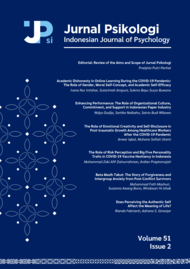Eksplorasi Gaya Respons Ekstrem dalam Mengisi Kuesioner
Wahyu Widhiarso(1*)
(1) Fakultas Psikologi Universitas Gadjah Mada
(*) Corresponding Author
Abstract
This study aimed to apply the mixture Rasch Model Analysis techniques to identify the proportion of students who possess extreme response styles when completing the questionnaire. Total 2.981 high school students from 30 cities in 15 provinces were instructed to complete questionnaires measuring self-esteem. Self-Self-Esteem Scale consists of four self-reported sub-scales using Likert's model. Analysis suggest that based on how to respond to the scale, student in this study was grouped into three classes: extreme response style class, normal class, and mixture class. These numbers of class were consistent on all four sub-scales. The proportion of students who consistently gave an extreme response on four sub-scales was 4 percent; 6 percent was on three sub-scale, 13 percent on two sub-scales and 53 percent on one sub-scale. The small percentage of students who responded consistently gave an extreme responses suggest that high-school students appropriately choose an option response that represent their trait.
Full Text:
PDFReferences
Amiruddin. (2008). Persepsi Siswa SMP 1 Negeri Sigli terhadap Penghijauan. Jurnal Pendidikan Serambi, 5(2), 62-65.
Austin, E. J., Deary, I. J., & Egan, V. (2006). Individual differences in response scale use: Mixed Rasch modelling of responses to NEO-FFI items. Personality and Individual Differences, 40(6), 1235-1245. doi: 10.1016/j.paid.2005.10.018
Biderman, M. D., & Reddock, C. M. (2012). The relationship of scale reliability and validity to respondent inconsistency. Personality and Individual Differences, 52(5), 647-651. doi: 10.1016/j.paid.2011.12.012
Crandall, J. E. (1965). Some Relationships among Sex, Anxiety, and Conservatism of Judgment. Journal of Personality, 33(1), 99-107. doi: 10.1111/j.1467-6494.1965.tb01374.x
Eid, M., & Zickar, M. J. (2007). Detecting response styles and faking in personality and organizational assessments by mixed Rasch models. In M. Von Davier & C. Carstensen (Eds.), Multivariate and Mixture Distribution Rasch Models. New York: Springer.
Fischer, R. (2004). Standardization to Account for Cross-Cultural Response Bias. Journal of Cross-Cultural Psychology, 35(3), 263-282. doi: 10.1177/0022022104264122
Gonyea, R. M. (2005). Self-reported data in institutional research: Review and recommendations. New Directions for Institutional Research.(127), 73-89. doi: 10.1002/ir.156
Hadjam, M. N. R., Martaniah, S. M., Prawitasari, J. E., & Masrun. (2004). The role of hardiness in somatization disorders Anima Indonesian Psychological Journal, 19(2), 122-135.
Harzing, A. W., & 26 Collaborators. (2009). Rating versus ranking: What is the best way to reduce response and language bias in cross-national research? . International Business Review, 18(417-432). doi: 10.1016/j.ibusrev.2009.03.001
Henry, M. S., & Raju, N. S. (2006). The effects of traited and situational impression management on a personality test: an empirical analysis. Psychology Science, 48(3), 247-267.
Kieruj, N., & Moors, G. (2011). Response style behavior: question format dependent or personal style? Quality & Quantity, 1-19. doi: 10.1007/s11135-011-9511-4
Knowles, E. S., & Nathan, K. T. (1997). Acquiescent Responding in Self-Reports: Cognitive Style or Social Concern? Journal of Research in Personality, 31(2), 293-301. doi: 10.1006/jrpe.1997.2180
Krosnick, J. A. (1991). Response strategies for coping with the cognitive demands of attitude measures in surveys. Applied Cognitive Psychology, 5(3), 213-236. doi: 10.1002/acp.2350050305
Mariyani, D. (2011). Hubungan antara sikap siswa terhadap pelajaran matematika dengan prestasi belajar matematika pada siswa SMK N. (Skripsi), UIN Sunan Kalijaga Yogyakarta, Yogyakarta.
Meisenberg, G., Lawless, E., Lambert, E., & Newton, A. (2006). The social ecology of intelligence on a Caribbean island. Mankind Quarterly, 46, 395–433.
Meisenberg, G., & Williams, A. (2008). Are acquiescent and extreme response styles related to low intelligence and education? Personality and Individual Differences, 44(7), 1539-1550. doi: 10.1016/j.paid.2008.01.010
Oppenheim, A. N. (1992). Questionnaire design, interviewing and attitude measurement (new ed.). New York, NY: Pinter Publishers.
Peer, E., & Gamliel, E. (2011). Too reliable to be true? Response bias as a potential source of inflation in paper-and-pencil questionnaire reliability. Practical Assessment, Research & Evaluation, 16(9), 1-8.
Rennie, L. J. (1982). Research Note: Detecting a response set to Likert-style attitude items with the rating model. Education Research and Perspectives, 9(1), 114-118.
Ridho, A. (2007). Karakteristik psikometrik tes berdasarkan pendekatan teori tes klasik dan teori respon aitem Jurnal Psikologi INSAN, 2(2), 1-27.
Roberson, T. G., & Miller, E. (1986). The Coopersmith Self-Esteem Inventory: A Factor Analytic Study. Educational and Psychological Measurement, 46(1), 269-273. doi: 10.1177/0013164486461033
Sudman, S. (1980). Reducing Response Error in Surveys. Journal of the Royal Statistical Society. Series D (The Statistician), 29(4), 237-273. doi: 10.2307/2987730
van Herk, H., Poortinga, Y. H., & Verhallen, T. M. M. (2004). Response Styles in Rating Scales. Journal of Cross-Cultural Psychology, 35(3), 346-360. doi: 10.1177/0022022104264126
von Davier, M. (2001). WINMIRA 2001. Kiel: Institute for Science Education.
Weijters, B., Geuens, M., & Schillewaert, N. (2008). The stability of individual response styles. Working Paper. Ghent University. Gent.
Weijters, B., Geuens, M., & Schillewaert, N. (2010). The Individual Consistency of Acquiescence and Extreme Response Style in Self-Report Questionnaires. Applied Psychological Measurement, 34(2), 105-121. doi: 10.1177/0146621609338593
Widhiarso, W. (2011). Aplikasi Model Rasch Campuran dalam Mengevaluasi Pengukuran Harga Diri Jurnal Penelitian dan Evaluasi Pendidikan, 17(1), 172-187.
Widhiarso, W. (2012). Aplikasi Teori Respons Butir untuk Mengidentifikasi Kecenderungan Responden Memilih Opsi Tengah pada Skala Psikologi. Proyeksi, 7(1), 33-43.
Widhiarso, W., & Retnowati, S. (2011). Investigasi butir bias jender dalam pengukuran depresi melalui Children's Depression Inventory (CDI). Jurnal Penelitian Psikologi, 2(1), 1-10.
Article Metrics
Refbacks
- There are currently no refbacks.
Copyright (c) 2016 Jurnal Psikologi
Recent Issues
 |  |  |  | ||||
| Vol 51 Issue 2 (2024) Page 120-230 | Vol 51 Issue 1 (2024) Page 1-119 | Vol 50 Issue 3 (2023) Page 219-332 | Vol 50 Issue 2 (2023) Page 125-218 |
| Published by Faculty of Psychology, Universitas Gadjah Mada, Indonesia Building D-6th, Floor No. D-606. Jl. Sosio Humaniora No. 1, Bulaksumur Yogyakarta, 55281 Email: jurnalpsikologi@ugm.ac.id Phone/whatsApp: +6281125210175 |











